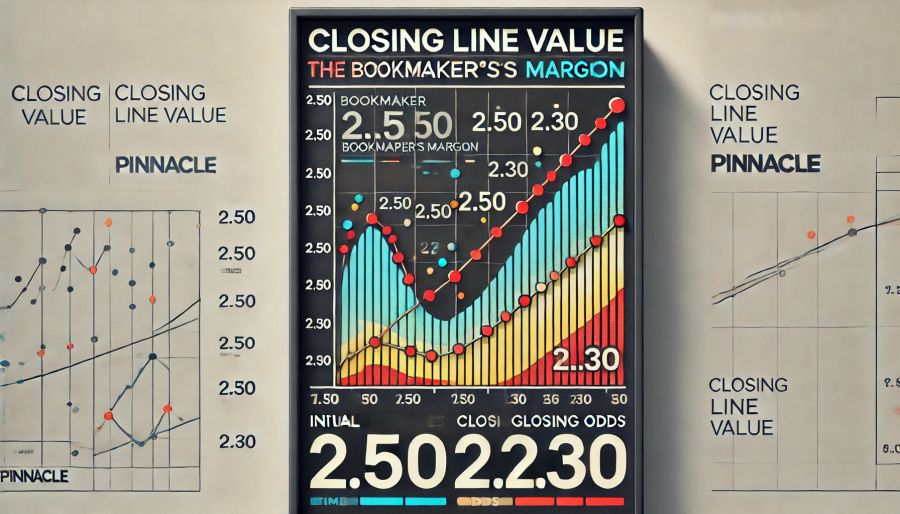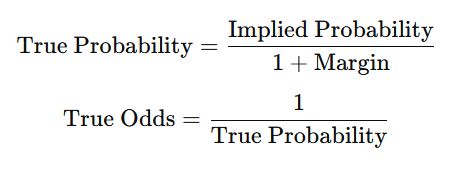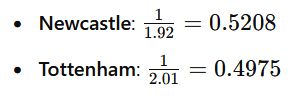Betting
Closing Line Value (CLV) Applied to Sports Betting: A Key Indicator for Bettors
In the world of sports betting, the quest for winning strategies and effective evaluation methods is constant. Among the many indicators used by savvy bettors, the Closing Line Value (CLV), or closing odds value, stands out for its effectiveness in measuring the quality of predictions.
By comparing the odds offered at the time of the bet with those available just before the event starts, the CLV helps determine if a bettor is truly beating the market. This article explores in depth what CLV is, how it’s calculated, the factors that influence it, and how to use it to improve betting performance.
What is Closing Line Value ?
Closing Line Value (CLV) is a metric used to evaluate the performance of bettors by comparing the odds at which a bet is placed with the closing odds of the market. The closing odds are the last odds available before the sporting event begins, reflecting all the information and wagers accumulated up to that moment.
The main goal of CLV is to determine if a bettor consistently gets better odds than the market. A positive CLV means that bets are placed at higher odds than the closing line, suggesting the bettor has a better evaluation of probabilities than the market. Conversely, a negative CLV indicates that the odds taken are lower than the closing odds, which may signal inefficiencies in the betting strategy.
In summary, CLV is an indicator of a bettor’s ability to identify superior value opportunities, which is essential for long-term profitability.
How is Closing Line Value Calculated ?
The calculation of Closing Line Value (CLV) relies on a simple comparison between the initial odds and the closing odds. Here are the detailed steps to perform this calculation:
Step 1: Record the odds at the time of the bet
When you place a bet, note the odds offered by the bookmaker at that moment. For example, if you bet on a football team with odds of 2.50, write down this value.
Step 2: Obtain the closing odds
Just before the sporting event begins, bookmakers adjust the odds based on new information, additional bets, and market dynamics. These final odds are called closing odds. Suppose the closing odds for your previous bet are 2.30.
Step 3: Compare the odds
Compare the odds at which you placed your bet (2.50) with the closing odds (2.30).
Step 4: Calculate the CLV
CLV can be expressed in several ways, but the most common method is to determine if the initial odds are higher or lower than the closing odds.
- Positive CLV: If your initial odds are higher than the closing odds (2.50 > 2.30), you have a positive CLV.
- Negative CLV: If your initial odds are lower than the closing odds (1.80 < 2.00), you have a negative CLV.
Basic CLV Formula:
*Initial Odds Initial Odds are the odds that the bettor takes

Example of Calculation
Suppose you placed 100 bets, and 60 of them have a positive CLV. This would indicate above-market performance, suggesting an effective betting strategy.

Including the Bookmaker's Margin in CLV Calculation
However, some mathematicians and sports betting analysts argue that calculating Closing Line Value (CLV) should not be limited to a simple comparison between the odds taken and the closing odds but should also account for the bookmaker's margin.
This more nuanced approach allows for a better evaluation of a bettor's real performance, considering market efficiency and the influence of the margin (or overround) imposed by the bookmaker.
What is the Bookmaker's Margin ?
The bookmaker's margin is a built-in commission in the odds offered. It ensures that the bookmaker makes a profit regardless of the outcome of the event. This margin is why the odds offered are always lower than the real probabilities calculated for a given event.
For example, if two teams in a football match have an equal probability of winning (50% each), the fair odds, without a margin, would be 2.00 for each team. However, due to the margin, the odds offered by a bookmaker might be 1.91 for each team to ensure a profit.
Why Include the Margin in CLV Calculation ?
The bookmaker’s margin distorts the perception of odds and, by extension, the raw CLV calculation if it’s not considered. Without adjusting for this margin, a bettor could conclude they have a positive CLV when, in fact, they are affected by the overround that skews the odds evaluation.
How to Include the Bookmaker's Margin in CLV Calculation ?
To incorporate the bookmaker's margin in CLV calculation, the odds must first be adjusted to reflect the real probabilities of the event, without the bookmaker's margin. This process is called converting raw odds to "true" odds.
a) Calculating the Bookmaker's Margin
The bookmaker's margin can be calculated using the odds offered for all possible outcomes of an event. The formula for calculating the overround is:

Example of Calculating the Bookmaker's Margin
Let’s take an example where the odds offered are identical, at 1.91 for each player in a tennis match.

In this example, the bookmaker's margin is 4.71%.
b) Converting Odds to True Probabilities
Once you have the margin, you can recalculate the odds without the margin, also called true or fair odds. The formula for calculating the true odds after removing the margin is:

Example:
Suppose you bet on a team with odds of 2.50. The closing odds for this same bet are 2.30. Without adjusting for the margin, you might think you have a positive CLV since the odds taken (2.50) are higher than the closing odds (2.30).
However, if the bookmaker applies a margin of 5%, the true odds without the margin could be closer to 2.40 (instead of 2.30). This means that, although you have slightly better odds than the closing odds, you haven’t really beaten the market since the true odds without the margin are very close to what you got.
The Importance of Including the Margin
Including the margin helps to understand whether the bettor truly overcomes the structural disadvantage posed by bookmakers. Bettors who manage to beat the market even after adjusting for the margin are generally more successful in the long term, as they surpass not only market fluctuations but also the bookmaker’s built-in advantage.
Limitations and Precautions
While adjusting for the margin improves the accuracy of the CLV calculation, it is not always easy to determine the exact margin, especially if an event has multiple possible outcomes or if different bookmakers apply different margins. Moreover, in less liquid or niche markets, margins can fluctuate significantly, further complicating the calculation.
Including the bookmaker's margin in the **Closing Line Value** calculation provides a more realistic assessment of a bettor's performance. By adjusting the odds to remove the influence of the margin, you can determine whether you are truly beating the market and whether your strategy is effective in the long run. Although this calculation is more complex, it is an essential tool for serious bettors seeking to optimize their approach and ensure lasting profitability.
Example: CLV on the Newcastle vs. Tottenham Match
The bookmaker’s margin for the Draw No Bet on the match between Newcastle and Tottenham, with odds of 1.92 for Newcastle and 2.01 for Tottenham, is around 1.83%. This indicates that the bookmaker includes a relatively low margin for this type of bet at this particular moment.
1) What is the basic CLV for this bet ?
The Closing Line Value (CLV)** is calculated by comparing the odds at which the bet was placed (initial odds) with the closing odds (final odds) for the same bet. In this case, since the closing odds are the same as those when the bet was placed (1.92 for Newcastle), the basic CLV is 0.
Basic CLV Formula:

This means that the odds at the time the bet was placed are the same as the closing odds, so there was no change in value on
this bet in terms of odds. The basic CLV is neutral.
2) What would be the CLV, including the margin, for this bet ?
To calculate the CLV adjusted for the bookmaker's margin, we must first adjust the initial and closing odds to remove the bookmaker's margin. This will give us the true or fair odds, which we will then use to compare the value obtained with the odds without the margin.
Steps to Calculate CLV Adjusted for the Margin:
1. Calculate the implied probabilities for both initial and final odds:
The implied probabilities (without the margin) for both the initial and closing odds are calculated by removing the bookmaker’s margin.

For the odds of 1.92 for Newcastle (Draw No Bet) and 2.01 for Tottenham (Draw No Bet), we get the following probabilities:

The sum of the probabilities is 0.5208 + 0.4975 = 1.0183, which includes the margin.
2. Remove the margin:
To remove the margin, we adjust the probabilities by dividing them by the total sum of the probabilities, which gives us the true probabilities:

3. Calculate the true odds without the margin:
Next, we convert these probabilities into true odds by inverting the adjusted probabilities:

4. Calculate the CLV adjusted for the margin:
Now that we have the true odds without the margin, we can calculate the CLV adjusted for the margin by using the initial odds and the true closing odds (without the margin).

Conclusion
1. The basic CLV is 0%, as the odds at the time of the bet and at closing are identical.
2. The CLV adjusted for the margin is -1.84%, meaning that even though the raw odds are the same, after adjusting for the bookmaker's margin, the bet shows a slight loss of value due to the margin’s influence.
4. What Factors Can Influence Closing Line Value ?
Several factors can influence **Closing Line Value** in sports betting. Understanding these parameters allows you to optimize your betting strategies and increase your chances of success.
Social Media Influencers with Large Followings
Influencers on social media with large audiences can affect market odds by sharing their predictions. When a popular influencer recommends a team or specific outcome, it can lead to increased betting on that option, shifting the closing odds. If the initial odds offered by the bookmaker are based on independent analysis, unaffected by the influencer's popularity, this can create a positive CLV.
Tipsters in Low Liquidity Markets
Low liquidity markets are characterized by a low volume of bets, meaning that even small wagers can cause large fluctuations in odds. Tipsters operating in these markets can exploit this inefficiency by placing bets before the odds are significantly adjusted by other bettors’ wagers, generating a favorable CLV.
Tipsters in Niche Sports
Niche sports or less popular leagues often have less monitored markets and fewer available data. Tipsters specializing in these areas can identify opportunities where the odds are mispriced by the bookmakers, thus increasing their CLV. For example, a tipster expert in handball or eSports may have a better understanding of the specific dynamics of these sports, offering more advantageous betting odds.
Timing of Bets
The timing of when a bet is placed relative to the closing odds plays a crucial role. Placing bets early, before new information or massive wagers adjust the odds, can allow for more favorable odds. Conversely, waiting too long may reduce CLV as the odds adjust based on market movements.
Insider Information
Bettors with access to **insider information** or insights not available to the public can anticipate odds movements and place advantageous bets before this information is reflected in the closing odds.
In-depth Knowledge of the Sport
A deep understanding of the nuances of a particular sport allows bettors to detect inefficiencies in the odds set by bookmakers. Bettors who better understand team strategies, individual performances, and other internal dynamics can identify value opportunities that others or the bookmakers have not yet exploited.
5. How to Beat Closing Line Value Regularly
To beat the Closing Line Value regularly, it is essential to adopt a methodical and disciplined approach. Here are some key strategies:
Thorough Research and Analysis
Invest time in analyzing sporting events, reviewing statistics, trends, team and player performances, as well as game conditions. A deep understanding allows you to spot opportunities where the market misprices the odds.
Rigorous Bankroll Management
Effective bankroll management is crucial to survive the variance inherent in sports betting. Set appropriate betting units and stick to your staking plan to avoid significant losses that could erode your capital.
Value Betting
Systematically look for bets where you estimate that the implied probabilities of the odds are lower than the actual probability of the event. This means identifying situations where the offered odds provide more value than the real probability, thus increasing CLV.
Optimal Timing of Bets
Identifying the best moment to place a bet can improve CLV. Betting early, before key information or large wagers adjust the odds, can allow you to benefit from more favorable odds.
Using Multiple Bookmakers
Compare odds across different bookmakers to find the best offers available. Using multiple betting platforms can maximize the value of your bets and improve your CLV by consistently obtaining the best odds.
Specialization
Focus on specific sports, leagues, or markets where you have deep expertise. Specialization allows you to spot inefficiencies that other bettors or bookmakers might overlook, thus improving your CLV.
Continuous Performance Evaluation
Track your bets and regularly analyze your CLV to identify strengths and weaknesses in your strategy. Adjust your approach based on the results to continuously optimize your performance.
Emotional Control
Avoid letting **emotions** influence your betting decisions. Stay objective and follow your strategy in a disciplined manner, even after wins or losses. Managing emotions is essential to maintaining a positive CLV over the long term.
6. Is the Closing Line a Reliable Indicator in the Long Term ?
The Closing Line Value is widely considered a reliable indicator of a bettor's performance over the long term, for several reasons:
Market Efficiency
Sports betting markets, especially those with high liquidity, tend to be quite efficient, meaning that the odds reflect all available information. If a bettor can consistently obtain higher odds than the closing line, it indicates that they have information or analysis superior to the market, which is a sign of skill.
Independence from Variance
The CLV accounts for the relationship between initial odds and closing odds, thus reducing the impact of random fluctuations on performance. A positive CLV indicates a trend of placing bets at favorable odds, which, statistically, should translate into profitability in the long term.
Correlation with Profits
Empirical studies show that a positive CLV is strongly correlated with long-term profitability for bettors. Those who consistently achieve positive CLV are more likely to generate sustainable profits, as they exploit persistent inefficiencies in the odds.
Resilience to External Factors
CLV is less influenced by temporary factors or event-specific outcomes, as it is aggregated over many bets. This provides a more reliable overview of a bettor’s skill, avoiding biases tied to isolated events.
Limitations and Precautions
However, it is important to note that CLV is not a guarantee of success. It should be used in conjunction with other performance measures, such as return on investment (ROI), win rate, and a qualitative analysis of betting strategies. Additionally, the reliability of CLV depends on the accuracy of closing odds data and consistent methodology in its calculation.
In summary, while CLV is a powerful and reliable indicator over the long term, it should be integrated into a broader approach to betting analysis and management.
7. Conclusion
Closing Line Value is a valuable tool for sports bettors seeking to evaluate and improve their performance objectively and systematically. By comparing initial odds with closing odds, CLV helps measure a bettor’s ability to identify superior value opportunities, essential for ensuring long-term profitability.
To maximize CLV, it is crucial to adopt a disciplined approach, combining thorough analysis, rigorous bankroll management, and a constant search for value in betting. Additionally, understanding the parameters that influence CLV, such as social media influencers, low liquidity markets, and niche sports, allows for better exploitation of market inefficiencies.
Finally, while CLV is a reliable indicator, it should be used alongside other performance measures to gain a complete view of betting skills. By integrating CLV into a comprehensive strategy and staying disciplined, bettors can improve their chances of success and achieve sustainable profitability in sports betting.
Wednesday, September 11, 2024
In my same category
Betting
Why Bet2invest Sets the Standard for Accurate Football Match Predictions
Thursday, November 20, 2025
The demand for accurate football match predictions has never been higher. With millions of bettors searching for reliable information every day, the online sports forecasting world has become increasingly competitive and sophisticated. The era when footba...
See the articleBetting
Bet Smarter: B2I's Auto-Betting Endorsed by Pinnacle, explained
Thursday, November 13, 2025
Auto-betting, or Copy-Betting, is a major innovation that is transforming the way bettors follow tipsters: your tipsters’ picks are placed automatically in under a second, without any manual action. At Bet2Invest, we’ve developed an ultra-reliable and sec...
See the articleBetting
Does Data Science Really Improve Football Betting Accuracy?
Tuesday, November 11, 2025
In recent years, data science has become one of the most transformative forces in modern sports. From player tracking to real-time analytics, the football industry now operates on data, and betting is no exception.Bookmakers, analysts, and professional be...
See the articleBet2Invest is not a bookmaker and does not offer sports betting services. However, its content is related to sports betting activities.
Gambling is strictly prohibited for minors. Play responsibly — excessive gambling can lead to financial loss, debt, or addiction.